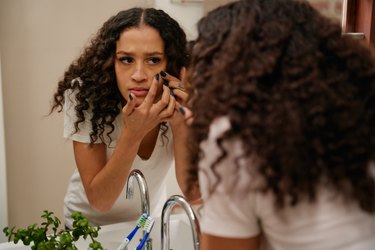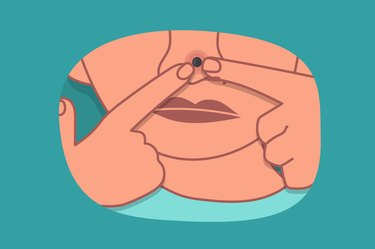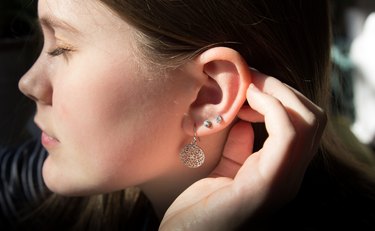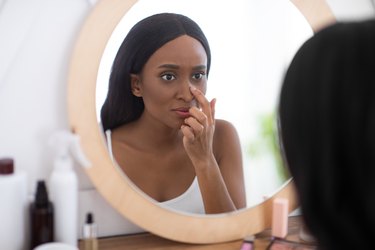
You know you're not really supposed to be poking and prodding at a pimple. But let's be honest: We all do it once in a while. And sometimes it can be pretty painful. So what's causing the hurt — and is there anything you can do to stop it?
To understand why pimples hurt, it helps to first get clear on what pimples actually are. These raised, red spots are blockages that develop when hair follicles on the skin get clogged with dead skin cells, oil or bacteria, according to the Mayo Clinic. And it's this blockage that can lead to discomfort.
Video of the Day
Video of the Day
When bacteria or other gunk clog a pore, the result can be an infection. The immune system responds by attempting to fight off the infection, which causes the area to become red, swollen, inflamed and tender to the touch, explains Tashara Lester, FNP-C, a certified family nurse practitioner specializing in dermatology at U.S. Dermatology Partners in Dallas.
In some cases, the pimple might have a raised white center — a sign of pus underneath. But hard, raised pimples without pus can be tender too, according to the Cleveland Clinic.
How to Relieve Pimple Pain
Rule number one: Resist the urge to pick at or pop your pimple, Lester says. Squeezing will likely only make the pimple hurt more. Plus, it can increase the risk for infection (or make an existing one worse) and lead to scarring, says the American Academy of Dermatology (AAD).
Once you've committed to keeping those fingers away, try these simple, at-home steps. Often they're all that's needed to make a pimple less painful and help it clear up. Here's what you can do:
1. Start With Ice
"One can apply ice wrapped in a paper towel and apply it to the pimple for five to 10 minutes, with 15-minute breaks in between icing," Lester says. This will take down the swelling and the pain ASAP.
2. Apply Benzoyl Peroxide
Dab on an acne spot treatment containing 2 percent benzoyl peroxide, like Neutrogena On-The-Spot Acne Treatment ($8.89, Amazon.com). This can help kill the bacteria that causes acne, and in turn reduce inflammation and swelling, says Lester. Another option is an acne treatment containing salicylic acid.
3. Move on to Warm Compresses
Start applying a warm washcloth once you notice your pimple starting to form a white center. "Apply the compress for five to 10 minutes at a time, two to three times a day," Lester recommends.
Another treatment option is to apply a pimple patch (such as Mighty Patch; $10.77, Amazon.com) once a white head forms. This will help to express the drainage more safely and effectively than "popping" the white head by applying pressure with your fingers.
When to See a Dermatologist for Painful Pimples
See a board-certified dermatologist if you've been dealing with painful pimples for more than a month and at-home or over-the-counter treatments aren't helping, Lester recommends. These could be signs of cystic acne, a severe type of inflammatory acne that can be difficult to treat at home.
Also see a physician if a cystic lesion continues to grow or causes eye swelling, fever or other symptoms.
Your doctor may opt to use a corticosteroid injection to quickly shrink the cyst or open up the cyst to drain it, the Cleveland Clinic says. They may also recommend trying prescription-strength topical creams or oral pills to clear up smaller blemishes and help keep new ones from forming.
Is this an emergency? If you are experiencing serious medical symptoms, please see the National Library of Medicine’s list of signs you need emergency medical attention or call 911.


